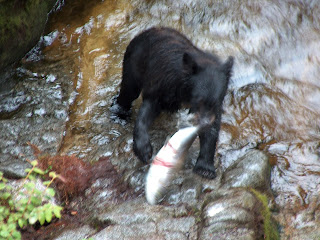
With kayaks weighed down with 5 weeks of food and gear, 13 of us set off to study ecology and policy of the Tongass National Forest in Southeast Alaska. One of our stops was Anan Bear Observatory operated by the U.S. Forest Service. It is accessible only by boat or float plane and requires very limited, difficult to get permits. The focal point is Anan Creek that supports the largest run of pink salmon in Southeast Alaska. It is estimated that 300,000 fish make their way up the creek to spawn and die from late June through September. And, where salmon are found, so are the bear that feed on them. Black and brown (brownies aka grizzles) in close proximity to each other with cubs, feeding on an endless bounty. This is the vantage of the observatory as we watched quietly with amazement.

The pink salmon that run here are also called Humpbacks or “Humpies” because of the pronounced hump that the males develop on their back after they begin spawning. They can weigh up to 12 pounds but more commonly weigh 3 to 5 pounds at maturity, and their two-year life cycle is the shortest of all the salmon species. Because they return to spawn after approximately 18 months at sea, each year’s pink salmon never mix with another’s, so runs in odd and even numbered years become genetically isolated and radically different in size.

Anan Creek is also an area of rich history. The Stikine Tlingit clans had summer fish camps here and used Anan Creek’s large salmon spawning run to catch and preserve salmon for their winter food supply. Anan was unique because the large amount of salmon available made it possible to have several clans sharing one fish camp.
The abundance of salmon also drew non-native people to Anan Creek. In 1901, Pilot Fish Packing Company set up a large fish trap at Anan that allowed few fish to make it up the creek. This lack of escapement was very destructive to the Anan salmon population. Commercial fish traps were outlawed shortly after Alaska became a state in 1959.

I was conflicted as I intruded into the Anan Creek ecosystem where I as a human, did not participate and only benefited anthropocentrically. However, it was there that I found a greater reverence for wilderness and an obligation to protect it. I had journeyed to Anan to observe the bear and I departed with a greater understanding of the complexity of nature that will always remain with me. Simply put, without salmon there will be no bear. Perhaps this was the inception of my personal responsibility for there to be a future for salmon.
Wonderful Wendy. Reminds me of our first interview way back when! Although now, of course, it's even more reflective.
ReplyDeleteIt sounds like an amazing journey Wendy. I grew up with bears in my neighbourhood and lived a short distance from Capilano river - a major spawning river in the area and so I too am aware of that synergy. Salmon = bears = fertile soil = berries = bears, and on.
ReplyDeleteHi Wendy,
ReplyDeleteThose pictures are amazing. That trip seemed to be transforming for you in so many ways. Was it this experience that initiated your passion for salmon?
Sam
Carolyn, I'm so happy to share the experience of "that synergy" with you. Those momments in life are to never be forgotten and cherished.
ReplyDeleteSam, I definately gained an appreciation for salmon and ALL wildlife on that trip. We infact ate vegetarian the whole time-lots of beans and tofu though the story of the Donner party came to mind a few times. The psyche does some crazy things when you are cold, wet, tired and hungry:)
Wendy, Amazing! and incredible pictures! Thank you!
ReplyDeleteElise